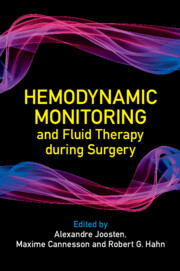56 results
Section 4 - Future Directions
-
- Book:
- Hemodynamic Monitoring and Fluid Therapy during Surgery
- Published online:
- 11 April 2024
- Print publication:
- 02 May 2024, pp 257-257
-
- Chapter
- Export citation
Frontmatter
-
- Book:
- Hemodynamic Monitoring and Fluid Therapy during Surgery
- Published online:
- 11 April 2024
- Print publication:
- 02 May 2024, pp i-iv
-
- Chapter
- Export citation
Preface
-
- Book:
- Hemodynamic Monitoring and Fluid Therapy during Surgery
- Published online:
- 11 April 2024
- Print publication:
- 02 May 2024, pp xiii-xiv
-
- Chapter
- Export citation
8 - Colloid Fluids
- from Section 2 - Basic Science & Concepts in Fluid Therapy
-
-
- Book:
- Hemodynamic Monitoring and Fluid Therapy during Surgery
- Published online:
- 11 April 2024
- Print publication:
- 02 May 2024, pp 87-95
-
- Chapter
- Export citation
Index
-
- Book:
- Hemodynamic Monitoring and Fluid Therapy during Surgery
- Published online:
- 11 April 2024
- Print publication:
- 02 May 2024, pp 310-316
-
- Chapter
- Export citation
Section 2 - Basic Science & Concepts in Fluid Therapy
-
- Book:
- Hemodynamic Monitoring and Fluid Therapy during Surgery
- Published online:
- 11 April 2024
- Print publication:
- 02 May 2024, pp 67-67
-
- Chapter
- Export citation
Foreword by Jean-Louis Vincent
-
- Book:
- Hemodynamic Monitoring and Fluid Therapy during Surgery
- Published online:
- 11 April 2024
- Print publication:
- 02 May 2024, pp xi-xii
-
- Chapter
- Export citation
7 - Crystalloid Fluids
- from Section 2 - Basic Science & Concepts in Fluid Therapy
-
-
- Book:
- Hemodynamic Monitoring and Fluid Therapy during Surgery
- Published online:
- 11 April 2024
- Print publication:
- 02 May 2024, pp 77-86
-
- Chapter
- Export citation
Section 1 - Hemodynamic Monitoring in the Perioperative Period
-
- Book:
- Hemodynamic Monitoring and Fluid Therapy during Surgery
- Published online:
- 11 April 2024
- Print publication:
- 02 May 2024, pp 1-1
-
- Chapter
- Export citation
Contents
-
- Book:
- Hemodynamic Monitoring and Fluid Therapy during Surgery
- Published online:
- 11 April 2024
- Print publication:
- 02 May 2024, pp v-vi
-
- Chapter
- Export citation
Section 3 - Practical Use
-
- Book:
- Hemodynamic Monitoring and Fluid Therapy during Surgery
- Published online:
- 11 April 2024
- Print publication:
- 02 May 2024, pp 117-117
-
- Chapter
- Export citation
List of Contributors
-
- Book:
- Hemodynamic Monitoring and Fluid Therapy during Surgery
- Published online:
- 11 April 2024
- Print publication:
- 02 May 2024, pp vii-x
-
- Chapter
- Export citation
6 - Body Volumes and Fluid Kinetics
- from Section 2 - Basic Science & Concepts in Fluid Therapy
-
-
- Book:
- Hemodynamic Monitoring and Fluid Therapy during Surgery
- Published online:
- 11 April 2024
- Print publication:
- 02 May 2024, pp 67-76
-
- Chapter
- Export citation

Hemodynamic Monitoring and Fluid Therapy during Surgery
-
- Published online:
- 11 April 2024
- Print publication:
- 02 May 2024
Canadian Consensus Guidelines for the Diagnosis and Treatment of Autoimmune Encephalitis in Adults
-
- Journal:
- Canadian Journal of Neurological Sciences , First View
- Published online by Cambridge University Press:
- 05 February 2024, pp. 1-21
-
- Article
-
- You have access
- Open access
- HTML
- Export citation
Mega-analysis of association between obesity and cortical morphology in bipolar disorders: ENIGMA study in 2832 participants
-
- Journal:
- Psychological Medicine / Volume 53 / Issue 14 / October 2023
- Published online by Cambridge University Press:
- 27 February 2023, pp. 6743-6753
-
- Article
-
- You have access
- Open access
- HTML
- Export citation
Characterisation of age and polarity at onset in bipolar disorder
-
- Journal:
- The British Journal of Psychiatry / Volume 219 / Issue 6 / December 2021
- Published online by Cambridge University Press:
- 25 August 2021, pp. 659-669
- Print publication:
- December 2021
-
- Article
-
- You have access
- Open access
- HTML
- Export citation
18 - Effects on Fluid Balance
- from Section 2 - Targeting Effects
-
-
- Book:
- Personalized Anaesthesia
- Published online:
- 03 December 2019
- Print publication:
- 06 February 2020, pp 257-270
-
- Chapter
- Export citation
Best Practices in Social and Behavioral Research: A multisite pilot evaluation of the good clinical practice online training course
-
- Journal:
- Journal of Clinical and Translational Science / Volume 2 / Issue 2 / April 2018
- Published online by Cambridge University Press:
- 08 August 2018, pp. 95-102
-
- Article
-
- You have access
- Open access
- HTML
- Export citation
Index
-
- Book:
- Clinical Fluid Therapy in the Perioperative Setting
- Published online:
- 05 June 2016
- Print publication:
- 26 May 2016, pp 270-277
-
- Chapter
- Export citation



